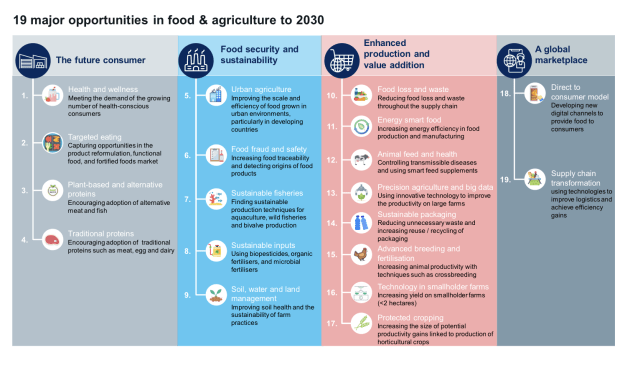There are 19 areas of growth opportunities to grow Australia’s food and agribusiness industry from its current $61 billion per year to more than $200 billion by 2030, a report by The Food & Agribusiness Growth Centre (FIAL) finds.
The Capturing the Prize report underpinned the opportunities with 10 trends it said impacted food production and consumption domestically and in key export markets; had potential to boost the industry’s competitiveness and economic significance; and stimulate employment.
It said a range of socioeconomic, geopolitical, technological, and consumer trends were converging in ways that would transform the food and agribusiness sector over the coming decade.
“It is also important to stress that we have focused on structural trends that are likely to be relevant over the 10-year period of focus, as opposed to more short-term ‘fads’ which may emerge and disappear,” the report said.
Rapidly emerging technologies transforming food production, distribution and tracking methods, and changing consumer preferences were all in the mix.
The food and agribusiness sector refers to opportunities in the agriculture, fishing, and food-related manufacturing value chain, including agricultural machinery, seeds, and packaged food products.
The 19 growth opportunity areas:
- Health and Wellness
- Plant-based and Alternative Proteins
- Traditional Proteins
- Supply Chain Transformation
- Targeted Eating
- Direct to Consumer Model
- Food Loss and Waste
- Soil, Water and Land Management
- Animal Feed and Health
- Food Fraud and Safety
- Energy Smart Food
- Sustainable Fisheries
- Urban Agriculture
- Protected Cropping
- Sustainable Packaging
- Technology in Smallholder Farms
- Precision Agriculture and Big Data
- Sustainable Inputs
- Advanced Breeding and Fertilisation

FIAL general manager of Innovation Dr Barry McGookin said, “To capture all the available growth opportunities, we must invest and innovate to drive better productivity and give the next generation the keys to succeed.
“Ensuring that Australia’s food and agribusiness sector is prepared to make the most of the exciting shifts in science, technology and consumer markets is FIAL’s central mission and the underlying purpose of our work.”
NSW Farmers CEO Pete Arkle said for New South Wales, the report showed enormous potential for farmers and producers to grow the economy, with the state making the biggest contribution in the country to the food and agribusiness sector.
The report found the sector employed 135,000 people as of February last year, but that could grow by 65 per cent if value-adding opportunities were realised.
“Nationally we’ve been talking about being a $100 billion industry by 2030, and FIAL’s work shows we could double that number to $200 billion,” Arkle said.
“By investing in value-adding, our farmers can produce ready-for-sale products instead of raw ingredients, and in turn we create more jobs and more economic activity for our communities.
“We already produce healthy plants and animals – there is huge potential to transition Australian agriculture into producing value-added healthy foods as well.”
The top three growth opportunities for New South Wales were supply chain transformation, improved soil, water and land management, and taking advantage of the direct-to-consumer market.
- In Victoria they were health and wellness, traditional proteins (meat, egg, dairy), and targeted eating;
- Queensland: health and wellness, traditional proteins, supply chain transformation;
- South Australia: health and wellness, traditional proteins, direct-to-consumer;
- Tasmania: soil, water, and land management, health and wellness, sustainable fisheries;
- Western Australia: supply chain transformation, health and wellness, and traditional proteins;
- Northern Territory: traditional proteins, animal feed and health, supply chain transformation;
- Queensland: health and wellness, traditional proteins, supply chain transformation; and
- ACT: direct-to-consumer model, food loss and waste, targeted eating.
To read the report, click here.






